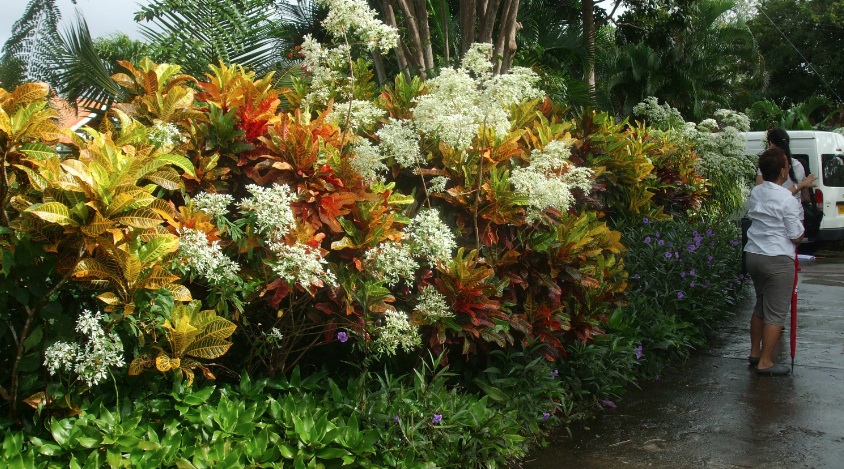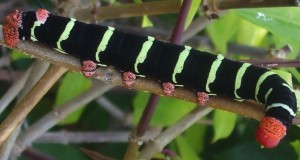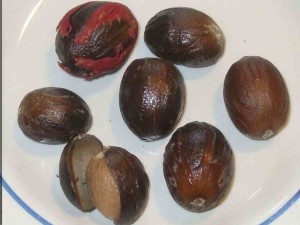
Hedge of crotons and euphorbia lines the driveway of a private garden in Grenada. (C) Jo Ellen Meyers Sharp/hoosiergardener.com
We really don’t expect much to be blooming in the Indiana garden this time of year except maybe a few hellebores (Helleborus) and witch hazels (Hamamelis). We celebrate seed heads, colorful stems and branches and evergreen or nearly evergreen plants for their winter interest.

Caterpillar of Pseudosphinx tetrio, which morphs into the hawk moth in Grenada. (C) Jo Ellen Meyers Sharp/hoosiergardener.com
But when I looked out the window of a resort in Grenada this past week, lush green foliage and splashes of colorful blooms steal the scene. (I was with a group of seven garden writers from the United States and Canada invited on a press tour of the West Indies island Jan. 9 through 13, 2011.)
In the Indiana University Union Building, there’s the Frangipani Room and in Grenada, I saw the tree (Plumeria). Like the one outside my resort room window, most of these trees had all their growth at the top, too far away to actually smell the fragrant, waxy white flower. Ian Blaikie, a guide at Sunsations Tours, explained the plant gets its common name from Frangipani, an Italian perfumer in the 1600s who created a plumeria-based scent to freshen gloves.
Denis Noel holds a giant Heliconia, which he grows on his farm for the cut flower trade in Grenada. (C) Jo Ellen Meyers Sharp/hoosiergardener.com
A frangipani tree we saw at Coyoba Beach Resort was covered a colorful caterpillar (Pseudosphinx tetrio), which has booted feet not unlike the caterpillar in Disney’s Alice in Wonderland and a big appetite. It morphs into a drab, brown night moth, called a hawk moth in Grenada. The moth is native from southern Brazil, Central America, Mexico, West Indies, Mississippi, Texas and southern Arizona, according to Butterflies and Moths of North America Web site. It reportedly has been seen as far north as Nebraska and Pennsylvania, the site says.

Traveler's palm gets its name because it holds water to quench the thirst of passersby. (C) Jo Ellen Meyers Sharp/hoosiergardener.com
The cocoa tree (Theobroma cacao) can be found just about everywhere, from private gardens and landscapes to commercial plantings. Also common: oleander (Nerium oleander), banana (Musa), royal palm (Roystonea oleracea), coconut palm (Cocos nucifera), traveler’s palm (Ravenala madagascariensis) and Bismark palm (Bismarckia nobilis).
Hedges are made of colorful crotons (Codiaeum variegatum) or Bougainvillea. The purple bougainvillea is Grenada’s national flower. Pink, yellow and white Alamanda and the exotic Heliconia serve up colorful flowers.
One of the most surprising plants, though, was the Euphorbia leucocephala, which looks like a giant version of Proven Winners’ Diamond Frost. Most of us thought this euphorbia was part of Diamond Frost’s parentage.

In the upper left is a recently harvested nutmeg, still covered by its red mace, which is the spice mace. Crack the shell and you get the nut, which is grated or ground in cooking. (C) Jo Ellen Meyers Sharp/hoosiergardener.com
Nutmeg (Myristica fragrans) is common throughout Grenada, known as the Spice Island. The shells of nutmeg frequently are used as mulches in garden beds or pathways.
Thanks to Carol Michel of May Dreams Gardens for being the host of Garden Bloggers’ Bloom Day the 15th of every month. If you are a garden blogger, write up what’s happening in your landscape and post at the Web site.
How fun to see plants in gardens that we normally see in conservatories. That Euphorbia is gigantic! So unlike what I think of when I think of Euphorbia.
Thanks for sharing some blooms from your trip with us for garden bloggers’ bloom day. I’m guessing you felt at times like Alice in Wonderland when you arrived in Grenada after being in snowy Indiana.